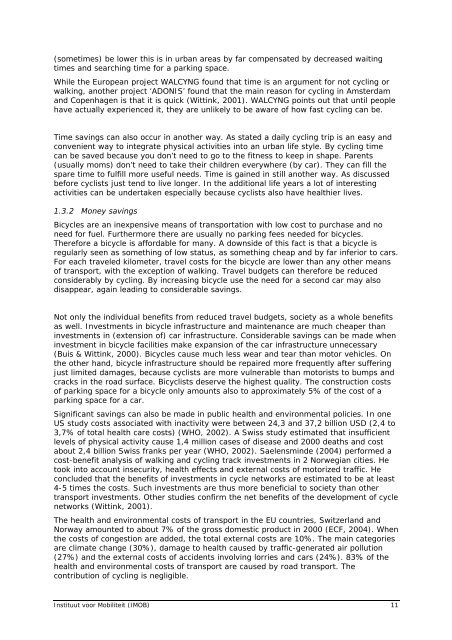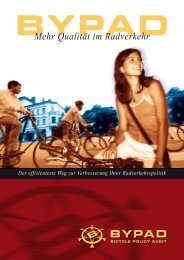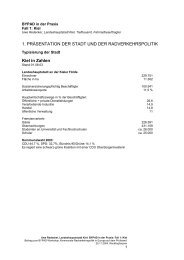Annex I: Literature search bicycle use and influencing ... - ByPAD
Annex I: Literature search bicycle use and influencing ... - ByPAD
Annex I: Literature search bicycle use and influencing ... - ByPAD
You also want an ePaper? Increase the reach of your titles
YUMPU automatically turns print PDFs into web optimized ePapers that Google loves.
(sometimes) be lower this is in urban areas by far compensated by decreased waiting<br />
times <strong>and</strong> <strong>search</strong>ing time for a parking space.<br />
While the European project WALCYNG found that time is an argument for not cycling or<br />
walking, another project ‘ADONIS’ found that the main reason for cycling in Amsterdam<br />
<strong>and</strong> Copenhagen is that it is quick (Wittink, 2001). WALCYNG points out that until people<br />
have actually experienced it, they are unlikely to be aware of how fast cycling can be.<br />
Time savings can also occur in another way. As stated a daily cycling trip is an easy <strong>and</strong><br />
convenient way to integrate physical activities into an urban life style. By cycling time<br />
can be saved beca<strong>use</strong> you don’t need to go to the fitness to keep in shape. Parents<br />
(usually moms) don’t need to take their children everywhere (by car). They can fill the<br />
spare time to fulfill more <strong>use</strong>ful needs. Time is gained in still another way. As discussed<br />
before cyclists just tend to live longer. In the additional life years a lot of interesting<br />
activities can be undertaken especially beca<strong>use</strong> cyclists also have healthier lives.<br />
1.3.2 Money savings<br />
Bicycles are an inexpensive means of transportation with low cost to purchase <strong>and</strong> no<br />
need for fuel. Furthermore there are usually no parking fees needed for <strong>bicycle</strong>s.<br />
Therefore a <strong>bicycle</strong> is affordable for many. A downside of this fact is that a <strong>bicycle</strong> is<br />
regularly seen as something of low status, as something cheap <strong>and</strong> by far inferior to cars.<br />
For each traveled kilometer, travel costs for the <strong>bicycle</strong> are lower than any other means<br />
of transport, with the exception of walking. Travel budgets can therefore be reduced<br />
considerably by cycling. By increasing <strong>bicycle</strong> <strong>use</strong> the need for a second car may also<br />
disappear, again leading to considerable savings.<br />
Not only the individual benefits from reduced travel budgets, society as a whole benefits<br />
as well. Investments in <strong>bicycle</strong> infrastructure <strong>and</strong> maintenance are much cheaper than<br />
investments in (extension of) car infrastructure. Considerable savings can be made when<br />
investment in <strong>bicycle</strong> facilities make expansion of the car infrastructure unnecessary<br />
(Buis & Wittink, 2000). Bicycles ca<strong>use</strong> much less wear <strong>and</strong> tear than motor vehicles. On<br />
the other h<strong>and</strong>, <strong>bicycle</strong> infrastructure should be repaired more frequently after suffering<br />
just limited damages, beca<strong>use</strong> cyclists are more vulnerable than motorists to bumps <strong>and</strong><br />
cracks in the road surface. Bicyclists deserve the highest quality. The construction costs<br />
of parking space for a <strong>bicycle</strong> only amounts also to approximately 5% of the cost of a<br />
parking space for a car.<br />
Significant savings can also be made in public health <strong>and</strong> environmental policies. In one<br />
US study costs associated with inactivity were between 24,3 <strong>and</strong> 37,2 billion USD (2,4 to<br />
3,7% of total health care costs) (WHO, 2002). A Swiss study estimated that insufficient<br />
levels of physical activity ca<strong>use</strong> 1,4 million cases of disease <strong>and</strong> 2000 deaths <strong>and</strong> cost<br />
about 2,4 billion Swiss franks per year (WHO, 2002). Saelensminde (2004) performed a<br />
cost-benefit analysis of walking <strong>and</strong> cycling track investments in 2 Norwegian cities. He<br />
took into account insecurity, health effects <strong>and</strong> external costs of motorized traffic. He<br />
concluded that the benefits of investments in cycle networks are estimated to be at least<br />
4-5 times the costs. Such investments are thus more beneficial to society than other<br />
transport investments. Other studies confirm the net benefits of the development of cycle<br />
networks (Wittink, 2001).<br />
The health <strong>and</strong> environmental costs of transport in the EU countries, Switzerl<strong>and</strong> <strong>and</strong><br />
Norway amounted to about 7% of the gross domestic product in 2000 (ECF, 2004). When<br />
the costs of congestion are added, the total external costs are 10%. The main categories<br />
are climate change (30%), damage to health ca<strong>use</strong>d by traffic-generated air pollution<br />
(27%) <strong>and</strong> the external costs of accidents involving lorries <strong>and</strong> cars (24%). 83% of the<br />
health <strong>and</strong> environmental costs of transport are ca<strong>use</strong>d by road transport. The<br />
contribution of cycling is negligible.<br />
Instituut voor Mobiliteit (IMOB) 11




